

Up: Variability of the HeI5876 Å
Subsections
According to Maitzen (1976), the silicon star HD22920 has a low value
of the photometric peculiarity index  (= 0.011). Photometric
observations have been carried out by Bartholdy (1988) who found this star
to be variable with a period of 3.95 d. North (1990 priv. comm.)
found two possible periods almost equally probable: 3.96 d, very close
to Bartholdy's (1988), and 1.33 d.
(= 0.011). Photometric
observations have been carried out by Bartholdy (1988) who found this star
to be variable with a period of 3.95 d. North (1990 priv. comm.)
found two possible periods almost equally probable: 3.96 d, very close
to Bartholdy's (1988), and 1.33 d.
No evidence of variability has been found in our spectra of the
HeI5876 Å line. The mean value
of the equivalent width is:  =
125
=
125  13 mÅ. The effective temperature of HD22920 resulting
from Napiwotzki et al. (1993) relation is
13 mÅ. The effective temperature of HD22920 resulting
from Napiwotzki et al. (1993) relation is  K.
Figure9 shows that the HeI5876 Å line equivalent width of HD22920
is smaller than expected for a main sequence star of the same effective
temperature.
K.
Figure9 shows that the HeI5876 Å line equivalent width of HD22920
is smaller than expected for a main sequence star of the same effective
temperature.
The UBV photometric variability of HD24155 has been studied by
Winzer
(1974), who reported a possible period of 2.5352 d. Renson & Manfroid (1981)
found P = 2.53465  0.00015 d. The observed light
curves show a quite large amplitude (0.10 mag) with very sharp minima
and quite broad maxima, hence this star is the fourth largest amplitude
silicon star known, exceeded only by HD215441, CU Vir and HR7058.
0.00015 d. The observed light
curves show a quite large amplitude (0.10 mag) with very sharp minima
and quite broad maxima, hence this star is the fourth largest amplitude
silicon star known, exceeded only by HD215441, CU Vir and HR7058.
Assuming Renson & Manfroid's (1981) period, our nine spectra are well
distributed in phase, but none of them shows a measurable HeI5876
Å line. Because of its effective temperature of 13700 K, HD24155 is
an extremely helium weak star (Fig.9).
HD24587 is listed in the General Catalogue of Ap and Am stars
by Renson et al. (1991) as a suspected CP star.
Feinstein (1978) used this star as standard for his measurements of
hydrogen lines in He weak stars. HD24587 has in fact been considered
as a standard for uvby (Garnier 1972 - personal communication to
Mathys et al. 1986) and  photometry
(Strauss & Ducati 1981).
Mathys et al. (1986) found this star to be a light variable with a period
of 1.728 d and concluded that the light curves resemble those of many CP
stars. Recently Leone & Catanzaro (1998) have performed a
spectroscopic study and concluded that this star presents chemical
elements which are slightly underabundant with respect to main sequence
stars.
photometry
(Strauss & Ducati 1981).
Mathys et al. (1986) found this star to be a light variable with a period
of 1.728 d and concluded that the light curves resemble those of many CP
stars. Recently Leone & Catanzaro (1998) have performed a
spectroscopic study and concluded that this star presents chemical
elements which are slightly underabundant with respect to main sequence
stars.
Our measurements of the HeI5876 Å line do not show any
variation of the equivalent width; the mean value is:  =
325
=
325  20 mÅ. From Moon's algorithm we find that
20 mÅ. From Moon's algorithm we find that  =
14100 K and the EW of the HeI5876 Å line is close to the value
expected for a main sequence star (Fig.9).
These facts confirm Leone & Catanzaro's (1998) conclusion that
HD24587 is not a peculiar star.
=
14100 K and the EW of the HeI5876 Å line is close to the value
expected for a main sequence star (Fig.9).
These facts confirm Leone & Catanzaro's (1998) conclusion that
HD24587 is not a peculiar star.
The peculiarity of HD26571 was first noted by Gulliver (1971) and
independently confirmed by Bond (1972). On the basis of his spectra,
Gulliver (1971) described this star as a spectrum variable.
Photometric observations were obtained by Winzer (1974),
who found HD26571 to vary with a period of 1.0646 d.
Figure 1 shows the EW variation of the HeI5876 Å line
versus the phase computed assuming the initial epoch coincident with the
light maximum as given by Winzer (1974):
|  |
(3) |
Winzer (1974) has not published the uncertainty in the period determination,
hence we have estimated the error by applying the Horne & Baliunas (1986)
relation to our data and have found that equivalent widths are phased with
an expected error  = 0.3. This means that no phase relation
can be determined between the photometric and our spectral variations.
= 0.3. This means that no phase relation
can be determined between the photometric and our spectral variations.
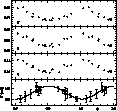 |
Figure 1:
Equivalent width variations of HD26571. The errorbar is
equal to the error in the equivalent width as given by Eq.(1).
Photometric data are from Winzer (1974). Phases have been computed by Eq.(3).
Open circles refer to the 1997 data, stars to the 1995 data.
The fitting of EW's performed by Eq.(2) is reported with a solid line.
The phase relation between EW and photometric variations may be not real
because of the large time gap between both data sets and the relatively
low accuracy of the variability period |
HD 28843 was classified as B9IV Si He-wk by Davis (1977) and it is classified
as B9 He wk in the General catalogue of Ap and Am Stars.
The photometric variability of HD28843 had been detected for the first
time by Cousins & Stoy (1966) while its peculiar character had been
confirmed by Jaschek et al. (1969). Photometric observations of this
star have been carried out by Pedersen & Thomsen (1977) who found
variability with a period of 1.374  0.006 d. This value was improved
by Pedersen (1979) to the value 1.37375
0.006 d. This value was improved
by Pedersen (1979) to the value 1.37375  0.00035 d.
Manfroid et al. (1984) also used Pedersen & Thomsen's (1977) data to improve
the period, their most probable value being 1.373813
0.00035 d.
Manfroid et al. (1984) also used Pedersen & Thomsen's (1977) data to improve
the period, their most probable value being 1.373813  0.000012 d.
Mathys et al. (1986) concluded that the ambiguity in the choice of the
best peak in the periodogram could be removed by inclusion of the
measurements of Dean (1980), confirming the value obtained by
Manfroid
et al. (1984). Further photometric observations have been carried out
by Waelkens (1985), by the team of the ESO Long-Term Photometry of
Variable Project (Manfroid et al. 1994; Sterken et al. 1995), and
by the team of Hipparcos (ESA, 1997).
0.000012 d.
Mathys et al. (1986) concluded that the ambiguity in the choice of the
best peak in the periodogram could be removed by inclusion of the
measurements of Dean (1980), confirming the value obtained by
Manfroid
et al. (1984). Further photometric observations have been carried out
by Waelkens (1985), by the team of the ESO Long-Term Photometry of
Variable Project (Manfroid et al. 1994; Sterken et al. 1995), and
by the team of Hipparcos (ESA, 1997).
Our spectroscopic data are plotted in Fig. 2, versus the
phase computed from the ephemeris elements of Mathys et al. (1986):
|  |
(4) |
The amplitude of the equivalent line width variations is of the order
of 75 mÅ. From Fig. 2 a clear anti-correlation is evident
between the HeI5876 Å equivalent line width and all the
Hipparcos and uvby light curves, in the sense that light minima occur
at the phase of maximum HeI. Because of the period error determined by
Manfroid et al. (1984), the expected phase error in our EW variations is
 = 0.03. EW variations of the HeI5876 Å line are then
out of phase with respect to light variations.
= 0.03. EW variations of the HeI5876 Å line are then
out of phase with respect to light variations.
Even if most of our equivalent widths periodically vary with the
ephemeris computed with Eq. (4), we have found several
(5 out of 21) spectra where the HeI5876 line is absent (Fig.2).
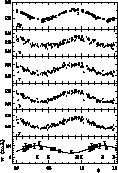 |
Figure 2:
Equivalent width variations of HD28843. The bar is
equal to the error in the equivalent width as given by Eq.(1).
Open circles refer to the 1997 data, stars to the 1995 data.
Photometric observations are from Hipparcos (ESA, 1997) and from
the ESO LTPV Project (Manfroid et al. 1994;
Sterken et al. 1995) |
In the General Catalogue of Ap and Am stars, the star HD36589 is a
suspected CP star.
Bossi & Guerrero (1989) and Hao et al. (1996) have used it as
a comparison star for photometric observations.
Leone & Catanzaro (1998) derived chemical abundances and found that
HD36589 shows nearly solar values and no evidence of spectral
variability.
From our spectra we confirm this result: no evidence of variation is
found in the HeI5876 Å equivalent line width. On the hypothesis that
HD36589 is not a CP star, we have determined  = 14000 K
by mean of Moon's relations and found that the average value of
the equivalent widths (
= 14000 K
by mean of Moon's relations and found that the average value of
the equivalent widths ( = 350
= 350  8 mÅ) is very
close to that of normal main sequence stars of the same spectral type
(Fig.9).
8 mÅ) is very
close to that of normal main sequence stars of the same spectral type
(Fig.9).
This star has been classified as B9p by Cowley et al. (1969) who described
it as a mild silicon star. On the basis of a single observing run in UBV,
Winzer (1974) found a period of 1.68 d, although he could not rule out
the resonance period of 2.47 d, because of the few observed points.
In our spectra the HeI5876 Å line is too weak to
be measured. According to Napiwotzki et al. (1993) relation,
 = 10800 K. Figure 9 shows that the helium
abundance is lower than the expected value for a main sequence star
of this temperature.
= 10800 K. Figure 9 shows that the helium
abundance is lower than the expected value for a main sequence star
of this temperature.
Cowley (1972) classified this star as B9IIIp Si. Photometric measurements
of HD43819 were performed in the UBV system by Winzer (1974) who found a
light variation with a period of 1.0785 d. Later on Maitzen (1980) found
the light variation to occur with two possible periods: 0.93 d and
1.077 d. A spectroscopic study of this sharp-lined star ( km s-1, Wolff & Preston 1978) was carried out by
Lopez-Garcia
& Adelman (1994), who found iron peak elements ten times overabundant
and rare earths 1000 times overabundant with respect to solar values.
From photometric uvby observations Adelman (1997) has deduced a
period of 15.0305
km s-1, Wolff & Preston 1978) was carried out by
Lopez-Garcia
& Adelman (1994), who found iron peak elements ten times overabundant
and rare earths 1000 times overabundant with respect to solar values.
From photometric uvby observations Adelman (1997) has deduced a
period of 15.0305  0.0003 d, longer than Winzer's (1974) and more
consistent with the low rotational velocity of this star. This period is
also confirmed by the Hipparcos observations (Fig.3).
0.0003 d, longer than Winzer's (1974) and more
consistent with the low rotational velocity of this star. This period is
also confirmed by the Hipparcos observations (Fig.3).
Our HeI5876 Å equivalent line widths are plotted
in Fig. 3 versus the phase computed by means of Adelman's
(1997) ephemeris elements:
|  |
(5) |
The observed EW variation has an amplitude of the order of 80 mÅ.
From Fig. 3 we see a clear in-phase correlation between light
and spectral variations. This correlation is expected to be real,
the phase error being  0.01.
0.01.
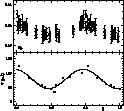 |
Figure 3:
Equivalent width variations of HD43819. Errorbar is equal
to the error in the equivalent width as given by Eq. (1).
Photometric data are from Hipparcos (ESA, 1997) |
The star HD49606 is classified as a B8HgMnSi star by Renson et al. (1991).
Photometric observations of HD49606 were performed by
Chunakova et al.
(1981), who found the light variations to occur with a period of 3.099 d,
and by Glagolevskii et al. (1985), who found two possible period values,
namely 3.3546 d and 1.41864 d.
The HeI5876 Å equivalent line width observed in our spectra
does not show any detectable variation, so that we consider this line
does not vary with time. The average equivalent width is  mÅ. This result confirms the one obtained by
Hubrig & Launhardt (1993) who searched for variations in the
equivalent width of helium and some metallic lines and did not find any
evidence of variability.
mÅ. This result confirms the one obtained by
Hubrig & Launhardt (1993) who searched for variations in the
equivalent width of helium and some metallic lines and did not find any
evidence of variability.
According to an elemental abundances analysis performed by
Adelman et al.
(1996) our observations show that helium is
underabundant with respect to solar composition (Fig.9).
The photometric variability of this star was detected by
North
(1992), who found the period to be 3.9124 d. This value of
the period is confirmed by the Hipparcos photometry (1997)
which gives an error on the period equal to 0.0004 d applying
Horne & Baliunas (1986) formula.
Computing the phase of the measured equivalent widths by means of
North's (1992) ephemeris:
| ![\begin{displaymath}
{\rm JD}([U]{\rm \, Geneva\, max}) = 2447178.245 + 3.9124\ E \end{displaymath}](/articles/aas/full/1999/02/h1046/img29.gif) |
(6) |
we find a sinusoidal variation of the HeI5876 Å line strength
(Fig.4) with an amplitude of the order of 45 mÅ.
Converting the period error to a phase error, we get  = 0.07.
We can thus conclude that
= 0.07.
We can thus conclude that  and EW variability are in phase for
the silicon star HD171247.
and EW variability are in phase for
the silicon star HD171247.
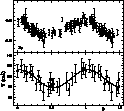 |
Figure 4:
Equivalent width variations of HD171247. the bar is equal
to the error in the equivalent width as given by Eq. (1).
Photometry is from Hipparcos (ESA, 1997) |
This star is classified as a silicon star (Renson et al. 1991).
Spectroscopic observations of the HeI4026 Å line strength were
carried out by Pedersen (1976), who found a variation
with the period 0.8143 d. The period is not representative of
the variability of Hipparcos photometry and HeI5876 Å equivalent
width.
By using our spectroscopic data and Hipparcos photometry we found a
period of 1.5817  0.0003 d. The observations are
plotted in Fig. 5 versus the phase computed by means of
the ephemeris elements:
0.0003 d. The observations are
plotted in Fig. 5 versus the phase computed by means of
the ephemeris elements:
|  |
(7) |
From this figure we see that both curves show a clear evidence of a
double-wave variation. The observed EW amplitude is of the order
of 40 mÅ.
The expected phase error is  = 0.05, and the Hipparcos
photometry appears to vary in phase with the equivalent width variations
of the HeI5876 Å line.
= 0.05, and the Hipparcos
photometry appears to vary in phase with the equivalent width variations
of the HeI5876 Å line.
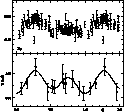 |
Figure 5:
Equivalent width variations of HD176582. Errorbar is equal
to the error in the equivalent width as given by Eq. (1).
Photometry is from Hipparcos (ESA, 1997) |
Schöneich & Zelwanowa (1984) from their photometric observations
in the UV filters found two possible periods: 0.66 d and 2.1 d.
From UBVRI photometric observations, Vetö (1993) found this star to
be light variable with a period of 0.724 d and amplitudes of about 0.1
mag in all filters. An analysis of Hipparcos photometric data does
not give a clear variability period.
Our spectroscopic data are not consistent with the periods given
in the literature. A period search of our data yelds two possible
values: 1.835  0.004 d and 2.186
0.004 d and 2.186  0.005 d. The HeI5876Å line
equivalent width variation is plotted in Fig. 6 versus the phase
computed by means of the ephemeris elements:
0.005 d. The HeI5876Å line
equivalent width variation is plotted in Fig. 6 versus the phase
computed by means of the ephemeris elements:
|  |
(8) |
where we have adopted the shorter value of the period which has a smaller
 value. The variation shown in Fig. 6 has an
amplitude of the order of 75 mÅ.
value. The variation shown in Fig. 6 has an
amplitude of the order of 75 mÅ.
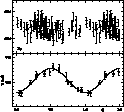 |
Figure 6:
Equivalent width variations of HD177003. Errorbar
is equal to the error in the equivalent width as given
by Eq. (1) |
The photometric variability is not clear for the  filter
assuming this period (Fig.6) and no conclusion can be drawn concerning a
possible phase relation between photometric and spectral variations
of the HeI5876Å line.
According to Hube & Aikman (1991) this star is a nonradial pulsator. It
has also been observed by Hipparcos, from whose photometry a period of
1.26239 d has been derived. However this value of the period is not
perfectly consistent with our spectroscopic observations; instead,
by using both sets of data the most probable value appears to be
1.26263
filter
assuming this period (Fig.6) and no conclusion can be drawn concerning a
possible phase relation between photometric and spectral variations
of the HeI5876Å line.
According to Hube & Aikman (1991) this star is a nonradial pulsator. It
has also been observed by Hipparcos, from whose photometry a period of
1.26239 d has been derived. However this value of the period is not
perfectly consistent with our spectroscopic observations; instead,
by using both sets of data the most probable value appears to be
1.26263  0.00005 d. Adopting this period, the measured EW of
the HeI5876Å line are plotted in Fig. 7
versus the phase computed by means of the ephemeris elements:
0.00005 d. Adopting this period, the measured EW of
the HeI5876Å line are plotted in Fig. 7
versus the phase computed by means of the ephemeris elements:
|  |
(9) |
The observed EW amplitude is of the order of 65 mÅ.
Since the period error corresponds to a phase error  = 0.09,
the reported out of phase relation between photometric and helium line
variations is expected to be real (Fig.7).
= 0.09,
the reported out of phase relation between photometric and helium line
variations is expected to be real (Fig.7).
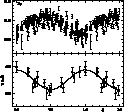 |
Figure 7:
The light and HeI5876 Å equivalent line width
variations of HD182255. Errorbar is equal to the error in the
equivalent width as given by Eq. (1). Photometry is from
Hipparcos (ESA, 1997) |
This star was classified as A0p by Osawa (1965) and as A0 IV by
Cowley
et al. (1969).
From his photometric observations, Winzer (1974) found a period of
0.63703 d, concluded that the observed photometric variation is
typical for a silicon star and suggested that the correct classification
should be A0p Si.
The equivalent width of the HeI5876Å line of the cool CP
star HD209515 is constant: 40  5 mÅ. This value of equivalent
width is consistent with the helium abundance of a main sequence star
(Fig.9).
5 mÅ. This value of equivalent
width is consistent with the helium abundance of a main sequence star
(Fig.9).
The variability of HD220825 had been detected for the first time by
Rakosch (1962) who found a period of 0.5805 d. Recently,
Ryabchikova et al. (1996) determined the period to be 1.418 d and magnetic observations
performed by Borra & Landstreet (1980) are also consistent with this
value.
The HeI 5876 Å line is too weak to be measured.
Assuming
5876 Å line is too weak to be measured.
Assuming  = 10400 K, Fig.9
shows that helium is underabundant in HD220825 with respect to main
sequence stars.
= 10400 K, Fig.9
shows that helium is underabundant in HD220825 with respect to main
sequence stars.
The photometric variability of this star has been studied by several
authors. Morrison & Wolff (1971) found HD223640 to be variable in
the Strömgren system with a period of 3.73 d and noted that light
curves show quite the same behaviour in all filters. Spectroscopic
observations were carried out by Megessier & Garnier (1972) who found
strongly variable the Ti and Sr lines and constant the Fe lines.
Moreover the Ti lines correlate with photometric variations in the
sense that Ti lines are strongest when the star is brightest. This
correlation has been interpreted by Megessier (1974, 1975) in terms of the
oblique rotator model taking also into account the sign changes of the
magnetic field measurements by Babcock (1958).
Photometric observations in the Geneva system have been performed by
North et al. (1992); they found a period of 3.735239  0.000024 d which
is consistent with the magnetic data. This period has been confirmed by
photometric observations in the uvby system performed by Adelman & Knox
(1994) and Adelman (1997).
0.000024 d which
is consistent with the magnetic data. This period has been confirmed by
photometric observations in the uvby system performed by Adelman & Knox
(1994) and Adelman (1997).
According to North et al. (1992), we phased the measured equivalent widths
of the HeI5876 Å line by means of the ephemeris elements:
|  |
(10) |
The period uncertainty corresponds to a phase error  = 0.004.
There is evidence of an anti-correlation between light and spectroscopic
curves. The HeI line is strongest in coincidence with the light minimum:
the helium distribution on the surface of HD223640 is then not coincident
with the Ti distribution.
= 0.004.
There is evidence of an anti-correlation between light and spectroscopic
curves. The HeI line is strongest in coincidence with the light minimum:
the helium distribution on the surface of HD223640 is then not coincident
with the Ti distribution.
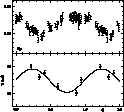 |
Figure 8:
Equivalent line width variations of HD223640. Errorbar is
equal to the error in the equivalent width as given by Eq. (1).
Photometry is from Hipparcos (ESA, 1997) |


Up: Variability of the HeI5876 Å
Copyright The European Southern Observatory (ESO)
![]() =
125
=
125 ![]() 13 mÅ. The effective temperature of HD22920 resulting
from Napiwotzki et al. (1993) relation is
13 mÅ. The effective temperature of HD22920 resulting
from Napiwotzki et al. (1993) relation is ![]() K.
Figure9 shows that the HeI5876 Å line equivalent width of HD22920
is smaller than expected for a main sequence star of the same effective
temperature.
K.
Figure9 shows that the HeI5876 Å line equivalent width of HD22920
is smaller than expected for a main sequence star of the same effective
temperature.
![]() =
325
=
325 ![]() 20 mÅ. From Moon's algorithm we find that
20 mÅ. From Moon's algorithm we find that ![]() =
14100 K and the EW of the HeI5876 Å line is close to the value
expected for a main sequence star (Fig.9).
These facts confirm Leone & Catanzaro's (1998) conclusion that
HD24587 is not a peculiar star.
=
14100 K and the EW of the HeI5876 Å line is close to the value
expected for a main sequence star (Fig.9).
These facts confirm Leone & Catanzaro's (1998) conclusion that
HD24587 is not a peculiar star.


![]() = 14000 K
by mean of Moon's relations and found that the average value of
the equivalent widths (
= 14000 K
by mean of Moon's relations and found that the average value of
the equivalent widths (![]() = 350
= 350 ![]() 8 mÅ) is very
close to that of normal main sequence stars of the same spectral type
(Fig.9).
8 mÅ) is very
close to that of normal main sequence stars of the same spectral type
(Fig.9).
![]() = 10800 K. Figure 9 shows that the helium
abundance is lower than the expected value for a main sequence star
of this temperature.
= 10800 K. Figure 9 shows that the helium
abundance is lower than the expected value for a main sequence star
of this temperature.

![]() mÅ. This result confirms the one obtained by
Hubrig & Launhardt (1993) who searched for variations in the
equivalent width of helium and some metallic lines and did not find any
evidence of variability.
mÅ. This result confirms the one obtained by
Hubrig & Launhardt (1993) who searched for variations in the
equivalent width of helium and some metallic lines and did not find any
evidence of variability.
![]() = 0.07.
We can thus conclude that
= 0.07.
We can thus conclude that ![]() and EW variability are in phase for
the silicon star HD171247.
and EW variability are in phase for
the silicon star HD171247.

![]() 0.0003 d. The observations are
plotted in Fig. 5 versus the phase computed by means of
the ephemeris elements:
0.0003 d. The observations are
plotted in Fig. 5 versus the phase computed by means of
the ephemeris elements:

![]() 0.004 d and 2.186
0.004 d and 2.186 ![]() 0.005 d. The HeI5876Å line
equivalent width variation is plotted in Fig. 6 versus the phase
computed by means of the ephemeris elements:
0.005 d. The HeI5876Å line
equivalent width variation is plotted in Fig. 6 versus the phase
computed by means of the ephemeris elements:


![]() 5 mÅ. This value of equivalent
width is consistent with the helium abundance of a main sequence star
(Fig.9).
5 mÅ. This value of equivalent
width is consistent with the helium abundance of a main sequence star
(Fig.9).
![]() 5876 Å line is too weak to be measured.
Assuming
5876 Å line is too weak to be measured.
Assuming ![]() = 10400 K, Fig.9
shows that helium is underabundant in HD220825 with respect to main
sequence stars.
= 10400 K, Fig.9
shows that helium is underabundant in HD220825 with respect to main
sequence stars.
